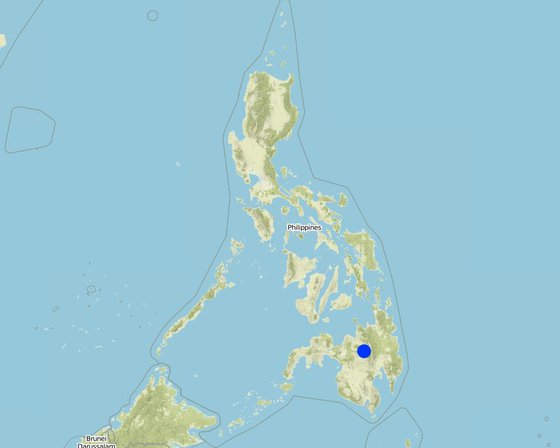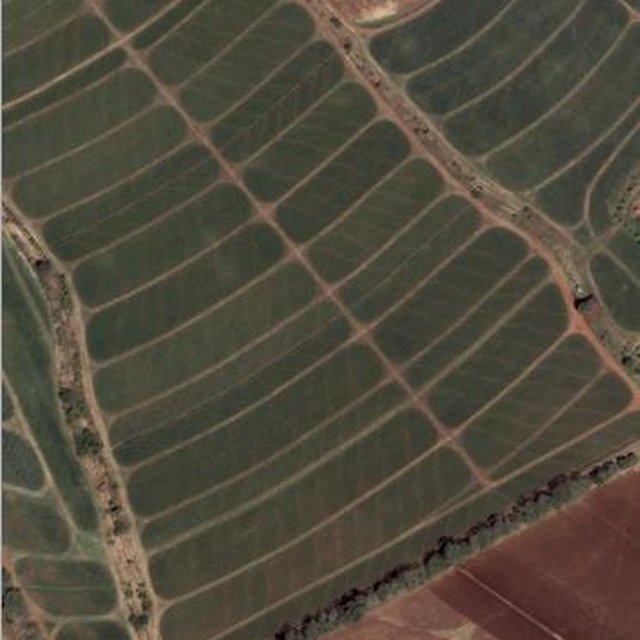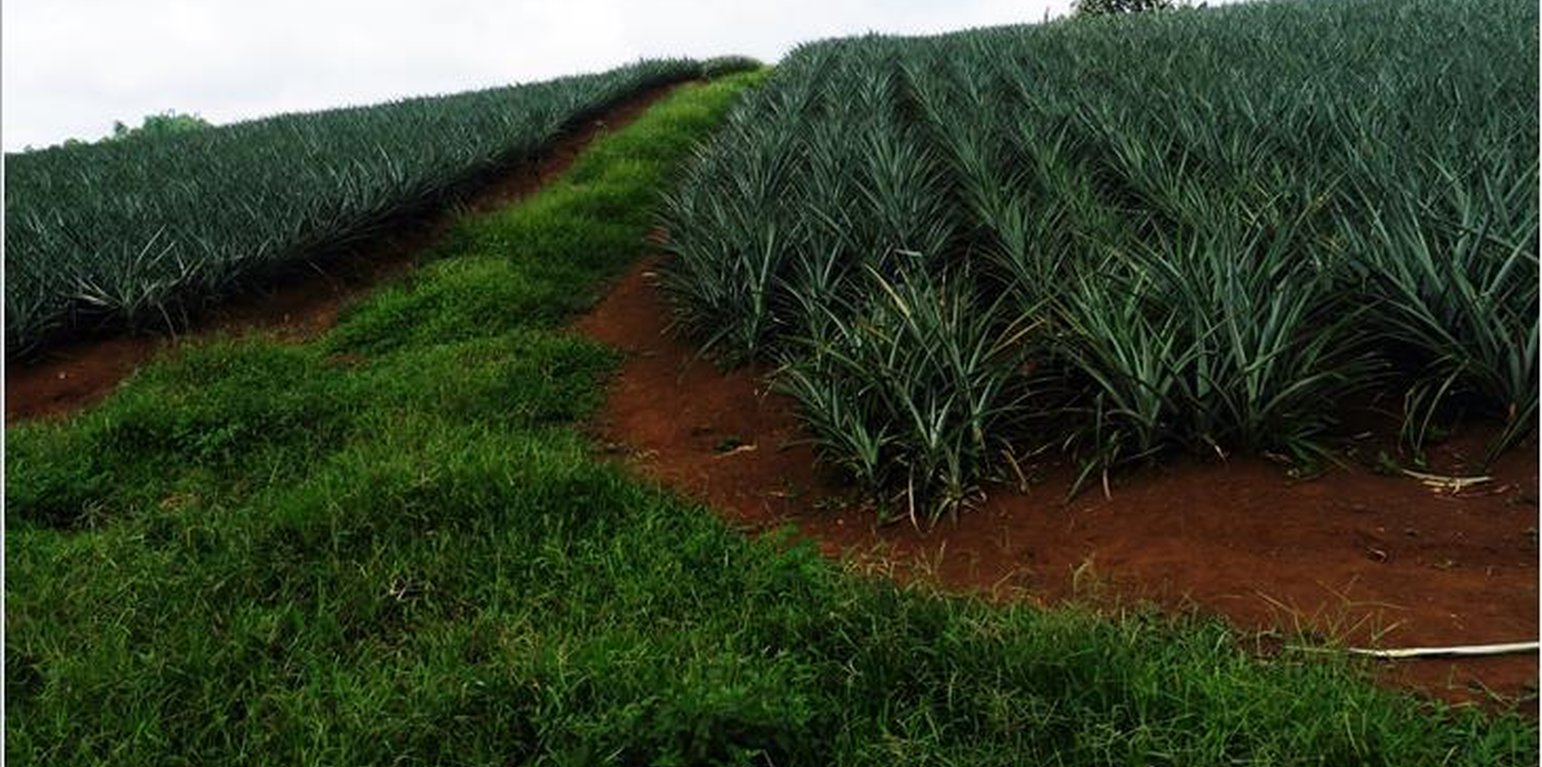Contour Straight Block Layout
(ฟิลิปปินส์)
คำอธิบาย
It is a package of soil and water conservation technology that integrates contouring, bedding, and blocking.
The main commodity used in the area is pineapple planted in each bed within blocks. Each block contains around 23-25 beds. Spaces between blocks with a dimension of 2-3 meters (width) served as vegetative strips where grass is being utilized and maintained. Grass as natural vegetative strips served as control for soil erosion by water. Vegetative strips are used as roads for accessibility purposes in times of planting and harvesting season. Pineapple production would last for 18-20 months for normal season and these requires massive land preparation. Plowing is done through a modified moldboard plow.
Purpose of the Technology: Pineapple were planted in beds within blocks, which is efficient and effective in water-induced soil erosion control.
Establishment / maintenance activities and inputs: Deep plowing,around one meter deep is a normal practice in the area. This practice would ensure proper root development of pineapple which is crucial for their growth; also it ensures re-introduction of pineapple trashes from the previous cropping as organic matter. Next activity is harrowing, which is usually done twice to pulverize the soil. Plastic mulching is a also a practice after bedding to suppress weeds and conserve water. Weeding is done manually. Foliar fertilizer spraying is done to induce flowering.
Natural / human environment: The area is under humid agro-climate condition with a topography ranging from 1-10% slope. It receives an annual average rainfall of approximately 3072 mm. The elevation ranges from 370-890 meter above sea level.
Mt. Kitanglad and Agri Development Corporation (MKADC) operates the area where the technology are being practiced. The technology has been introduced through experiments and adoption from neighboring farms. Farmers living within the area are the laborers of the company, they do all needed activities during preparation of the land, planting and harvesting.
สถานที่

สถานที่: Valencia City, Bukidnon, ฟิลิปปินส์
ตำนวนการวิเคราะห์เทคโนโลยี:
ตำแหน่งทางภูมิศาสตร์ของสถานที่ที่ถูกเลือ
การเผยแพร่ของเทคโนโลยี: กระจายไปอย่างสม่ำเสมอในพื้นที่ (approx. 1-10 ตร.กม.)
วันที่ในการดำเนินการ: 10-50 ปี
ประเภทของการแนะนำ
-
ด้วยการริเริ่มของผู้ใช้ที่ดินเอง
-
เป็นส่วนหนึ่งของระบบแบบดั้งเดิมที่ทำก้นอยู่ (> 50 ปี)
-
ในช่วงการทดลองหรือการทำวิจัย
-
ทางโครงการหรือจากภายนอก

Contour Straight Block Lay-out (Google Eath)
จุดประสงค์หลัก
-
ปรับปรุงการผลิตให้ดีขึ้น
-
ลด ป้องกัน ฟื้นฟู การเสื่อมโทรมของที่ดิน
-
อนุรักษ์ระบบนิเวศน์
-
ป้องกันพื้นที่ลุ่มน้ำ/บริเวณท้ายน้ำ โดยร่วมกับเทคโนโลยีอื่นๆ
-
รักษาสภาพหรือปรับปรุงความหลากหลายทางชีวภาพ
-
ลดความเสี่ยงของภัยพิบัติ
-
ปรับตัวเข้ากับการเปลี่ยนแปลงภูมิอากาศของโลก สภาพภูมิอากาศที่รุนแรงและผลกระทบ
-
ชะลอการเปลี่ยนแปลงภูมิอากาศของโลกและผลกระทบ
-
สร้างผลกระทบทางด้านเศรษฐกิจที่เป็นประโยชน์
-
สร้างผลกระทบทางด้านสังคมที่เป็นประโยชน์
การใช้ที่ดิน
-
พื้นที่ปลูกพืช - การปลูกพืชยืนต้นที่ไม่มีเนื้อไม้
พืชหลัก (พืชเศรษฐกิจและพืชอาหาร): Major cash crop: pineapple
การใช้น้ำ
-
จากน้ำฝน
-
น้ำฝนร่วมกับการชลประทาน
-
การชลประทานแบบเต็มรูปแบบ
จำนวนของฤดูปลูกต่อปี:
n.a.
การใช้ที่ดินก่อนการดำเนินการโดยเทคโนโลยี:
n.a.
ความหนาแน่นของปศุสัตว์:
n.a.
ความมุ่งหมายที่เกี่ยวข้องกับการเสื่อมโทรมของที่ดิน
-
ป้องกันความเสื่อมโทรมของที่ดิน
-
ลดความเสื่อมโทรมของดิน
-
ฟื้นฟูบำบัดที่ดินที่เสื่อมโทรมลงอย่างมาก
-
ปรับตัวกับสภาพความเสื่อมโทรมของที่ดิน
-
ไม่สามารถใช้ได้
ที่อยู่ของการเสื่อมโทรม
-
การกัดกร่อนของดินโดยน้ำ - Wt (Loss of topsoil): การสูญเสียดินชั้นบนหรือการกัดกร่อนที่ผิวดิน
กลุ่ม SLM
-
การจัดการความอุดมสมบรูณ์ของดินแบบผสมผสาน
มาตรการ SLM
-
มาตรการจัดการพืช - A1: พืช/สิ่งปกคลุมดิน
-
มาตรการอนุรักษ์ด้วยวิธีพืช - V2: หญ้าและไม้ยืนต้น
| | | | | | | | | | | |
|
แบบแปลนทางเทคนิค
ข้อมูลจำเพาะด้านเทคนิค
Each bed is within blocks. Vegetative strips width is approximately 2-3 meters. Contour lines with an approximate 0.5 meters width served as diversion ditches.
Location: Luguran, Valencia City Bukidnon
Technical knowledge required for field staff / advisors: moderate
Technical knowledge required for land users: moderate
Technical knowledge required for farmer level: moderate
Main technical functions: control of raindrop splash, control of dispersed runoff: retain / trap, control of dispersed runoff: impede / retard, control of concentrated runoff: retain / trap, control of concentrated runoff: impede / retard, control of concentrated runoff: drain / divert, stabilisation of soil (eg by tree roots against land slides)
Secondary technical functions: improvement of ground cover, increase of infiltration, increase / maintain water stored in soil
Relay cropping
Material/ species: pineapple
Remarks: in beds within contoured blocks
Contour planting / strip cropping
Material/ species: pineapple
Mulching
Material/ species: plastic mulching
Remarks: in each bed
Rotations / fallows
Material/ species: grassland
Breaking crust / sealed surface
Material/ species: modified molboard plow
Remarks: plowed accross the slope
In blocks
Vegetative material: C : perennial crops
Number of plants per (ha): 2000
Vertical interval between rows / strips / blocks (m): 0.5
Spacing between rows / strips / blocks (m): 0.5
Vertical interval within rows / strips / blocks (m): 0.3
Width within rows / strips / blocks (m): 0.3
Perennial crops species: pineapple
Layout change according to natural and human environment: the technology follows a fallow period.
|
การจัดตั้งและการบำรุงรักษา: กิจกรรม ปัจจัยและค่าใช้จ่าย
การคำนวนต้นทุนและค่าใช้จ่าย
- ค่าใช้จ่ายถูกคำนวน
- สกุลเงินที่ใช้คำนวณค่าใช้จ่าย Philippine peso
- อัตราแลกเปลี่ยน (ไปเป็นดอลลาร์สหรัฐ) คือ 1 ดอลลาร์สหรัฐ = 46.0 Philippine peso
- ค่าจ้างเฉลี่ยในการจ้างแรงงานต่อวันคือ 6.50
ปัจจัยที่สำคัญที่สุดที่มีผลต่อค่าใช้จ่าย
Planting materials and labour
กิจกรรมเพื่อการจัดตั้ง
-
Construction of vegetative strips. Vegetative strips has been prepared and laid out during land preparation ( agronomic measures) and is part of the paid labor . (ช่วงระยะเวลา/ความถี่: None)
-
Plowing, also included the preparation of vegetative strips. (ช่วงระยะเวลา/ความถี่: None)
-
Harrowing (ช่วงระยะเวลา/ความถี่: None)
-
Bedding (ช่วงระยะเวลา/ความถี่: None)
-
Mulching (ช่วงระยะเวลา/ความถี่: None)
-
Planting (ช่วงระยะเวลา/ความถี่: None)
ปัจจัยและค่าใช้จ่ายของการจัดตั้ง
| ปัจจัยนำเข้า |
หน่วย |
ปริมาณ |
ค่าใช้จ่ายต่อหน่วย (Philippine peso) |
ค่าใช้จ่ายทั้งหมดต่อปัจจัยนำเข้า (Philippine peso) |
%ของค่าใช้จ่ายที่ก่อให้เกิดขึ้นโดยผู้ใช้ที่ดิน |
|
แรงงาน
|
| Labourer |
ha |
1.0 |
143.0 |
143.0 |
100.0 |
|
อุปกรณ์
|
| Machine use |
ha |
1.0 |
225.0 |
225.0 |
100.0 |
|
วัสดุสำหรับก่อสร้าง
|
| Pineapple strings |
ha |
|
217.0 |
|
100.0 |
| ค่าใช้จ่ายทั้งหมดของการจัดตั้งเทคโนโลยี |
368.0 |
|
กิจกรรมสำหรับการบำรุงรักษา
-
Ratooning (ช่วงระยะเวลา/ความถี่: 1)
-
Spraying (ช่วงระยะเวลา/ความถี่: As needs arise)
-
Weeding (ช่วงระยะเวลา/ความถี่: As needs arise)
-
Fertilizer Application (ช่วงระยะเวลา/ความถี่: As needs arise but normally one to three times per cropping season)
-
Harvesting (ช่วงระยะเวลา/ความถี่: Once or twice per cropping season)
-
Trimming of grasses (ช่วงระยะเวลา/ความถี่: As needs arise)
ปัจจัยและค่าใช้จ่ายของการบำรุงรักษา
| ปัจจัยนำเข้า |
หน่วย |
ปริมาณ |
ค่าใช้จ่ายต่อหน่วย (Philippine peso) |
ค่าใช้จ่ายทั้งหมดต่อปัจจัยนำเข้า (Philippine peso) |
%ของค่าใช้จ่ายที่ก่อให้เกิดขึ้นโดยผู้ใช้ที่ดิน |
|
แรงงาน
|
| Labourer |
ha |
1.0 |
279.0 |
279.0 |
100.0 |
| ค่าใช้จ่ายทั้งหมดของการบำรุงรักษาสภาพเทคโนโลยี |
279.0 |
|
สิ่งแวดล้อมทางธรรมชาติ
ปริมาณน้ำฝนเฉลี่ยรายปี
-
< 250 ม.ม.
-
251-500 ม.ม.
-
501-750 ม.ม.
-
751-1,000 ม.ม.
-
1,001-1,500 ม.ม.
-
1,501-2,000 ม.ม.
-
2,001-3,000 ม.ม.
-
3,001-4,000 ม.ม.
-
> 4,000 ม.ม.
เขตภูมิอากาศเกษตร
-
ชื้น
-
กึ่งชุ่มชื้น
-
กึ่งแห้งแล้ง
-
แห้งแล้ง
ข้อมูลจำเพาะเรื่องภูมิอากาศ
3072 (Annual Average Rainfall)
Thermal climate class: tropics
ความชัน
-
ราบเรียบ (0-2%)
-
ลาดที่ไม่ชัน (3-5%)
-
ปานกลาง (6-10%)
-
เป็นลูกคลื่น (11-15%)
-
เป็นเนิน (16-30%)
-
ชัน (31-60%)
-
ชันมาก (>60%)
ภูมิลักษณ์
-
ที่ราบสูง/ที่ราบ
-
สันเขา
-
ไหล่เขา
-
ไหล่เนินเขา
-
ตีนเนิน
-
หุบเขา
ความสูง
-
0-100 เมตร
-
101-500 เมตร
-
501-1,000 เมตร
-
1,001-1,500 เมตร
-
1,501-2,000 เมตร
-
2,001-2,500 เมตร
-
2,501-3,000 เมตร
-
3,001-4,000 เมตร
-
> 4,000 เมตร
เทคโนโลยีถูกประยุกต์ใช้ใน
-
บริเวณสันเขา (convex situations)
-
บริเวณแอ่งบนที่ราบ (concave situations)
-
ไม่เกี่ยวข้อง
ความลึกของดิน
-
ตื้นมาก (0-20 ซ.ม.)
-
ตื้น (21-50 ซ.ม.)
-
ลึกปานกลาง (51-80 ซ.ม.)
-
ลึก (81-120 ซ.ม.)
-
ลึกมาก (>120 ซ.ม.)
เนื้อดิน (ดินชั้นบน)
-
หยาบ/เบา (ดินทราย)
-
ปานกลาง (ดินร่วน ทรายแป้ง)
-
ละเอียด/หนัก (ดินเหนียว)
เนื้อดิน (> 20 ซม. ต่ำกว่าพื้นผิว)
-
หยาบ/เบา (ดินทราย)
-
ปานกลาง (ดินร่วน ทรายแป้ง)
-
ละเอียด/หนัก (ดินเหนียว)
สารอินทรียวัตถุในดิน
-
สูง (>3%)
-
ปานกลาง (1-3%)
-
ต่ำ (<1%)
น้ำบาดาล
-
ที่ผิวดิน
-
<5 เมตร
-
5-50 เมตร
-
> 50 เมตร
ระดับน้ำบาดาลที่ผิวดิน
-
เกินพอ
-
ดี
-
ปานกลาง
-
ไม่ดีหรือไม่มีเลย
คุณภาพน้ำ (ยังไม่ได้รับการบำบัด)
-
เป็นน้ำเพื่อการดื่มที่ดี
-
เป็นน้ำเพื่อการดื่มที่ไม่ดี (จำเป็นต้องได้รับการบำบัด)
-
เป็นน้ำใช้เพื่อการเกษตรเท่านั้น (การชลประทาน)
-
ใช้ประโยชน์ไม่ได้
ความเค็มของน้ำเป็นปัญหาหรือไม่?
การเกิดน้ำท่วม
ความหลากหลายทางชนิดพันธุ์
ความหลากหลายของแหล่งที่อยู่
ลักษณะเฉพาะของผู้ใช้ที่ดินที่ประยุกต์ใช้เทคโนโลยี
เป้าหมายทางการตลาด
-
เพื่อการยังชีพ (หาเลี้ยงตนเอง)
-
ผสม (การเลี้ยงชีพ/ทำการค้า)
-
ทำการค้า/การตลาด
รายได้จากภายนอกฟาร์ม
-
< 10% ของรายได้ทั้งหมด
-
10-50% ของรายได้ทั้งหมด
-
> 50% ของรายได้ทั้งหมด
ระดับของความมั่งคั่งโดยเปรียบเทียบ
-
ยากจนมาก
-
จน
-
พอมีพอกิน
-
รวย
-
รวยมาก
ระดับของการใช้เครื่องจักรกล
-
งานที่ใช้แรงกาย
-
การใช้กำลังจากสัตว์
-
การใช้เครื่องจักรหรือเครื่องยนต์
อยู่กับที่หรือเร่ร่อน
-
อยู่กับที่
-
กึ่งเร่ร่อน
-
เร่ร่อน
เป็นรายบุคคลหรือกลุ่ม
-
เป็นรายบุคคล/ครัวเรือน
-
กลุ่ม/ชุมชน
-
สหกรณ์
-
ลูกจ้าง (บริษัท รัฐบาล)
อายุ
-
เด็ก
-
ผู้เยาว์
-
วัยกลางคน
-
ผู้สูงอายุ
พื้นที่ที่ใช้ต่อครัวเรือน
-
< 0.5 เฮกตาร์
-
0.5-1 เฮกตาร์
-
1-2 เฮกตาร์
-
2-5 เฮกตาร์
-
5-15 เฮกตาร์
-
15-50 เฮกตาร์
-
50-100 เฮกตาร์
-
100-500 เฮกตาร์
-
500-1,000 เฮกตาร์
-
1,000-10,000 เฮกตาร์
-
>10,000 เฮกตาร์
ขนาด
-
ขนาดเล็ก
-
ขนาดกลาง
-
ขนาดใหญ่
กรรมสิทธิ์ในที่ดิน
-
รัฐ
-
บริษัท
-
เป็นแบบชุมชนหรือหมู่บ้าน
-
กลุ่ม
-
รายบุคคล ไม่ได้รับสิทธิครอบครอง
-
รายบุคคล ได้รับสิทธิครอบครอง
สิทธิในการใช้ที่ดิน
-
เข้าถึงได้แบบเปิด (ไม่ได้จัดระเบียบ)
-
เกี่ยวกับชุมชน (ถูกจัดระเบียบ)
-
เช่า
-
รายบุคคล
สิทธิในการใช้น้ำ
-
เข้าถึงได้แบบเปิด (ไม่ได้จัดระเบียบ)
-
เกี่ยวกับชุมชน (ถูกจัดระเบียบ)
-
เช่า
-
รายบุคคล
เข้าถึงการบริการและโครงสร้างพื้นฐาน
ความช่วยเหลือทางด้านเทคนิค
การจ้างงาน (เช่น ภายนอกฟาร์ม)
ผลกระทบ
ผลกระทบทางด้านเศรษฐกิจและสังคม
ผลกระทบด้านสังคมและวัฒนธรรม
ความมั่นคงด้านอาหาร / พึ่งตนเองได้
Improved livelihoods and human well-being
ผลกระทบนอกพื้นที่ดำเนินการ
น้ำท่วมพื้นที่ท้ายน้ำ (ที่ไม่เป็นที่ต้องการ)
รายได้และค่าใช้จ่าย
ผลประโยชน์ที่ได้รับเปรียบเทียบกับค่าใช้จ่าย
ผลตอบแทนระยะสั้น
ด้านลบอย่างมาก
ด้านบวกอย่างมาก
ผลตอบแทนระยะยาว
ด้านลบอย่างมาก
ด้านบวกอย่างมาก
ผลประโยชน์ที่ได้รับเปรียบเทียบกับค่าใช้จ่ายในการบำรุงรักษา
ผลตอบแทนระยะสั้น
ด้านลบอย่างมาก
ด้านบวกอย่างมาก
ผลตอบแทนระยะยาว
ด้านลบอย่างมาก
ด้านบวกอย่างมาก
การเปลี่ยนแปลงของสภาพภูมิอากาศ
การเปลี่ยนแปลงสภาพภูมิอากาศที่ค่อยเป็นค่อยไป
อุณหภูมิประจำปี เพิ่มขึ้น
สภาพรุนแรงของภูมิอากาศ (ภัยพิบัติ)
การน้อมเอาความรู้และการปรับใช้
เปอร์เซ็นต์ของผู้ใช้ที่ดินในพื้นที่ที่นำเทคโนโลยีไปใช้
-
ครั้งเดียวหรือเป็นการทดลอง
-
1-10%
-
10-50%
-
มากกว่า 50%
จากทั้งหมดที่ได้รับเทคโนโลยีเข้ามามีจำนวนเท่าใดที่ทำแบบทันที โดยไม่ได้รับการจูงใจด้านวัสดุหรือการเงินใดๆ?
-
0-10%
-
10-50%
-
50-90%
-
90-100%
เทคโนโลยีได้รับการปรับเปลี่ยนเร็วๆ นี้เพื่อให้ปรับตัวเข้ากับสภาพที่กำลังเปลี่ยนแปลงหรือไม่?
สภาพที่กำลังเปลี่ยนแปลงอันไหน?
-
การเปลี่ยนแปลงแบบค่อยเป็นค่อยไปและสภาพรุนแรงของภูมิอากาศ
-
การเปลี่ยนแปลงของตลาด
-
การมีแรงงานไว้ให้ใช้ (เนื่องจากการอพยพย้ายถิ่นฐาน)
บทสรุปหรือบทเรียนที่ได้รับ
จุดแข็ง: มุมมองของผู้ใช้ที่ดิน
-
Good for erosion control
How can they be sustained / enhanced? Continued practice of the technology
จุดแข็ง: ทัศนคติของผู้รวบรวมหรือวิทยากรคนอื่นๆ
-
Ease of establishing the technology.
How can they be sustained / enhanced? More scientific research
-
Transferrability/ Acceptability
จุดด้อย/ข้อเสีย/ความเสี่ยง: มุมมองของผู้ใช้ที่ดินแก้ไขปัญหาได้อย่างไร
-
More researches should be done to prove the effectiveness and efficiency of the technology as soil and water conservation technology.
Allow research authorities to conduct researches in their farm.
จุดด้อย/ข้อเสีย/ความเสี่ยง: ทัศนคติของผู้รวบรวมหรือวิทยากรคนอื่นๆแก้ไขปัญหาได้อย่างไร
-
Somehow labor intensive
Mechanization but should be regulated, productivity of the soil should not be compromised.
การอ้างอิง
ผู้รวบรวม
-
Philippine Overview of Conservation Approaches and Technologies
ผู้ตรวจสอบ
-
Eduardo Alberto
-
Alexandra Gavilano
วันที่จัดทำเอกสาร: 24 กรกฎาคม 2015
การอัพเดทล่าสุด: 22 พฤษภาคม 2017
วิทยากร
-
Baldwin Pine (baldwinmp@gmail.com) - ผู้เชี่ยวชาญ SLM
-
Jerry Manubag (manubagjerry@gmail.com ) - ผู้เชี่ยวชาญ SLM
-
Djolly Ma Dinamling - None
-
Teodoro M. Bersabe - None
-
Gloria Betonio - None
คำอธิบายฉบับเต็มในฐานข้อมูล WOCAT
การจัดทำเอกสารถูกทำโดย
องค์กร
- Bureau of Soils and Water Management (Bureau of Soils and Water Management) - ฟิลิปปินส์
- Mt. Kitanglad and Agri Development Corporation (MKADC) - ฟิลิปปินส์
โครงการ









